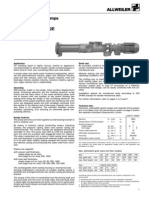0 ratings0% found this document useful (0 votes)
71 viewsCourse Syllabus Power System Analysis Lec. Lab.
This 3 unit course covers power system analysis through lecture, laboratory work, problem solving and assignments. The course objectives are to analyze various aspects of power systems, understand power flow studies and fault analysis, and expose students to fundamental power system principles. Topics include elements of power system analysis, economic operation, modeling components, load flow analysis, short circuit analysis, and protection systems. Assessment includes quizzes, exams and assignments. The goal is for students to learn modeling, power flow calculation, fault analysis, stability determination, and economic dispatch.
Uploaded by
Monique OrugaCopyright
© © All Rights Reserved
Available Formats
Download as PDF, TXT or read online on Scribd
0 ratings0% found this document useful (0 votes)
71 viewsCourse Syllabus Power System Analysis Lec. Lab.
This 3 unit course covers power system analysis through lecture, laboratory work, problem solving and assignments. The course objectives are to analyze various aspects of power systems, understand power flow studies and fault analysis, and expose students to fundamental power system principles. Topics include elements of power system analysis, economic operation, modeling components, load flow analysis, short circuit analysis, and protection systems. Assessment includes quizzes, exams and assignments. The goal is for students to learn modeling, power flow calculation, fault analysis, stability determination, and economic dispatch.
Uploaded by
Monique OrugaCopyright
© © All Rights Reserved
Available Formats
Download as PDF, TXT or read online on Scribd
You are on page 1/ 2
COURSE SYLLABUS POWER SYSTEM ANALYSIS LECTURE/LABORATORY
COURSE CODE EE 4121
DESCRIPTIVE TITLE Power System Analysis Lecture/Laboratory
CREDITS UNITS 3 Units
CONTACT HOURS T 6:00 p.m. to 9:00 p.m.
Engr. Joel A. Eligue
INSTRUCTOR
Faculty Member, College of Engineering
W.D. Stevenson and J.J. Grainger. (2013). Power System Analysis,
McGraw Hill
B.M. Weedy, B.J. Cory, N. Jenkins, J.B. Ekanayake, and G. Strbac.
TEXTBOOK
(2012). Electric Power Systems,5th Edition. John Wiley & Sons
Ltd
H. Saadat. (1999). Power System Analysis, McGraw Hill
S. Khan. (2008). Industrial Power System, CRC Press.
Other Supplemental
V.K. Mehta. (2011). Principles of Power System, S. Chand & Company
Materials
ltd
COURSE OUTLINE
A. Course Description
This course deals with the study on the basic structure of power systems, recent trends and innovations in
power systems, transmission line parameters, network modeling and calculations, load flow studies, short
circuit calculations and use of computer software for simulation.
B. Prerequisites Electrical Standards and Practices
C. Modality Synchronous
D. Method of Teaching Lecture, Seatwork, Recitation, Problem Solving
LEARNING OUTCOMES
A. Course Objective
By the end of the course, the students will be able to:
1. Analyzing various aspects of power systems;
2. Understand the power flow studies, fault analysis and stability studies;
3. To familiarize the basis for power system operation, control and protection;
4. To expose to the fundamental principles of power system analysis;
B. Course Outline
1. Elements of Power System Analysis
2. Economic operation of power systems
3. Modelling power system components
4. Load flow analysis
5. Short circuit analysis and calculations
6. Power system protection: selection and coordination of protection system
C. Student Outcomes
a. Model major types of components used in electrical power systems. .
b. Calculate the steady-state power flow in a power system.
c. Analyze different types of short-circuit faults.
d. Calculate the power system dynamics and its stability.
e. Determine the economic dispatch in a power system.
f. Understand power system control.
COURSE TOPICS
Prelim Period Topics and Activities (Weeks 1–6)
I. Introduction: Discussion and presentation of the Syllabus and Course Requirements and Course
Introduction.
II. Elements of Power System Analysis: Introduction and fundamentals on power system.
III. Economic operation of power systems: Economic operation of power systems.
IV. Seatwork, Quiz, Assignment, and Prelim Examination
Midterm Period Topics and Activities (Week 7-12)
V. Modelling power system components: Modelling power system components.
VI. Load flow analysis: Load flow analysis.
VII. Seatwork, Quiz, Assignment, and Midterm Examination
Final Period Topics and Activities (Weeks 13–18)
VIII. Short circuit analysis and calculations: Short circuit analysis and calculations.
IX. Power system protection: Selection and coordination of protection system.
X. Seatwork, Quiz, Assignment, and Final Examination
Prepared by: Reviewed by: Approved by:
Engr. Joel A. Eligue
Faculty, College of Engineering
You might also like
- LS 25S Parts Manual Generation I Model PDF100% (2)LS 25S Parts Manual Generation I Model PDF76 pages
- Gujarat Technological University: Page 1 of 4No ratings yetGujarat Technological University: Page 1 of 44 pages
- Course Outline - 1136098903introduction To Power Systems Course OutlineNo ratings yetCourse Outline - 1136098903introduction To Power Systems Course Outline2 pages
- Course Outline For Power System ProtectionNo ratings yetCourse Outline For Power System Protection2 pages
- ISSN 2277 3916 CVR Journal of Science and Technology, Volume 8, June 2015No ratings yetISSN 2277 3916 CVR Journal of Science and Technology, Volume 8, June 20156 pages
- ME Electrical Power Electronics and DrivesNo ratings yetME Electrical Power Electronics and Drives48 pages
- Muthayammal Engineering College, RASIPURAM 637408 (Autonomous)No ratings yetMuthayammal Engineering College, RASIPURAM 637408 (Autonomous)205 pages
- A Steady-State Model of The Photovoltaic System in Emtp: H. I. Cho, S. M. Yeo, C. H. Kim, V. TerzijaNo ratings yetA Steady-State Model of The Photovoltaic System in Emtp: H. I. Cho, S. M. Yeo, C. H. Kim, V. Terzija6 pages
- 3. TY BTech. Electrical Syllabus AY 2023-24 (2)No ratings yet3. TY BTech. Electrical Syllabus AY 2023-24 (2)65 pages
- M.SC - in Electrical and Comp Control EngNo ratings yetM.SC - in Electrical and Comp Control Eng36 pages
- ME01000131 Computer Techniques in Power SystemNo ratings yetME01000131 Computer Techniques in Power System4 pages
- EE2004 1 Nature of Electrical Energy System UpdateNo ratings yetEE2004 1 Nature of Electrical Energy System Update65 pages
- Gujarat Technological University: W.E.F. AY 2018-19No ratings yetGujarat Technological University: W.E.F. AY 2018-193 pages
- Distribution of Electrical Power: Lecture Notes of Distribution of Electrical Power CourseFrom EverandDistribution of Electrical Power: Lecture Notes of Distribution of Electrical Power CourseNo ratings yet
- OrugaMoniqueCaila (BSEE4thYear) @ReflectionOnFCLNo ratings yetOrugaMoniqueCaila (BSEE4thYear) @ReflectionOnFCL4 pages
- OrugaMoniqueCaila (BSEE4thYear) @ReflectionOnFCLNo ratings yetOrugaMoniqueCaila (BSEE4thYear) @ReflectionOnFCL4 pages
- Gravitation: Arride Learning Online E-Learning AcademyNo ratings yetGravitation: Arride Learning Online E-Learning Academy25 pages
- Chapter 4 - Non-Uniform Flow in Open ChannelNo ratings yetChapter 4 - Non-Uniform Flow in Open Channel140 pages
- Bidirectional power flow in an electric vehicle using predictive control algorithm including sneak circuit analysisNo ratings yetBidirectional power flow in an electric vehicle using predictive control algorithm including sneak circuit analysis12 pages
- Advantages and Disadvantages of air coolerNo ratings yetAdvantages and Disadvantages of air cooler152 pages
- ELTR 270 - Diode Practice Problems and Solutions100% (1)ELTR 270 - Diode Practice Problems and Solutions33 pages
- Premature Failures in Plate Bonded Strengthened RC Beams With An Emphasis On Premature Shear A Review PDFNo ratings yetPremature Failures in Plate Bonded Strengthened RC Beams With An Emphasis On Premature Shear A Review PDF13 pages
- Operating System and Memory: Presentation OnNo ratings yetOperating System and Memory: Presentation On31 pages
- SW Full M16X2PX70 A193 B7 ZN Al SM0000000002 - BlankingNo ratings yetSW Full M16X2PX70 A193 B7 ZN Al SM0000000002 - Blanking1 page
- Antenna 2201 0L 2M 0H 1.7m: Capacity Compact CoverageNo ratings yetAntenna 2201 0L 2M 0H 1.7m: Capacity Compact Coverage5 pages
































































































